Astrid Preston
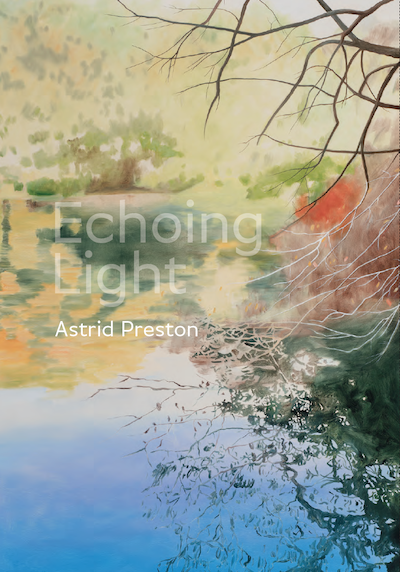
ECHOING LIGHT
Exhibition at R.B.Stevenson Gallery
June 16 – July 14, 2018
FREEZING FLUX: ART AND ARTIFICE IN ASTRID PRESTON'S PAINTINGS
by Robert L. Pincus
What do painters manage to do when they paint water? Simply put, they take something in perennial flux and freeze that flux for our contemplation and delight. But one sign of magic in a painting is that it arrests the sense of water in motion, while also evoking its dynamic state in the mind’s eye. Heraclitus may have been correct in saying “no man steps into the same river twice,” but art can make it possible to revisit it twice in our imaginations.
Ever since the advent of perspective, in the early 1400s, we have been in thrall of the way we can render the space of the world in such a way as to mirror it. The rational mind knows this is an illusion; it is a triumph of artifice. It is so persuasive that we have had a hard time seeing it as a pictorial convention, art historian E.H. Gombrich demonstrated eloquently in Art and Illusion. But that doesn’t diminish the pleasure we take in the illusions of perspective, when artists use them well.
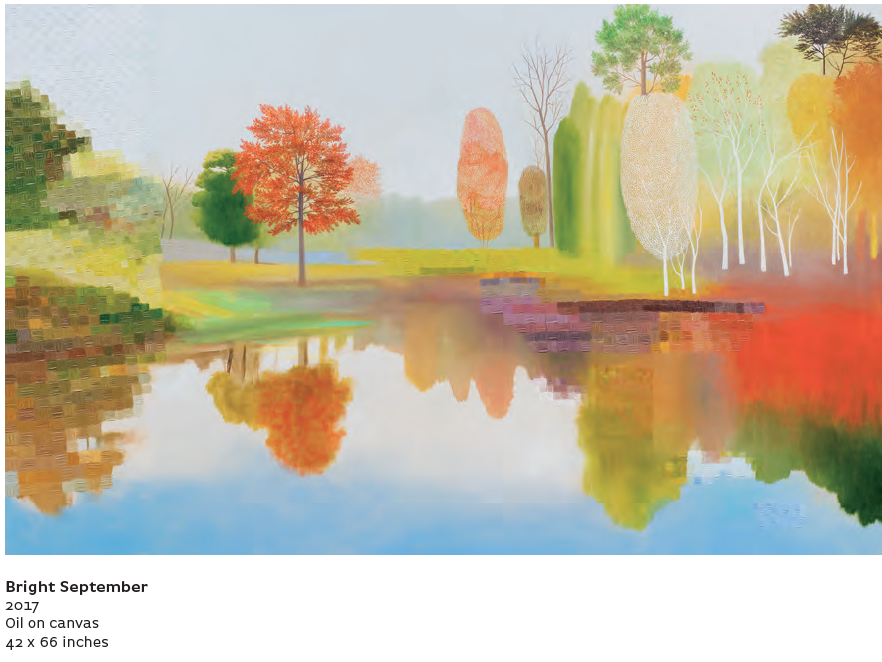 The space of water really isn’t always that cooperative with the methods and laws of perspective. Even when the most empirical of late 19th century realists, Thomas Eakins, painted water, the realism looks a bit fantastical. In his remarkable The Champion Single Sculls (1871), the vast expanse of the river, with its many reflections of shoreline trees, makes us conscious of the way water distorts forms. And as Monet demonstrated with his indelible paintings of his gardens at Giverny, begun in 1899 and continuing into the 1920s, water could look real in a painting without looking realistic.
The space of water really isn’t always that cooperative with the methods and laws of perspective. Even when the most empirical of late 19th century realists, Thomas Eakins, painted water, the realism looks a bit fantastical. In his remarkable The Champion Single Sculls (1871), the vast expanse of the river, with its many reflections of shoreline trees, makes us conscious of the way water distorts forms. And as Monet demonstrated with his indelible paintings of his gardens at Giverny, begun in 1899 and continuing into the 1920s, water could look real in a painting without looking realistic.
The catalyst for this line of thought was my first viewing of Astrid Preston’s new paintings. Water is a central dimension of these images, for which her sources are Japanese gardens. And water is magnetic in these paintings, fixing our eyes on its inviting territory within the paintings. As in Eakins’ The Champion Single Sculls, there are two worlds: the realm of solid forms and the corresponding universe of reflections. And what persuasive paintings reveal, if we are paying close attention, is that in their field of vision, the solid world and the liquid world often have equal weight.
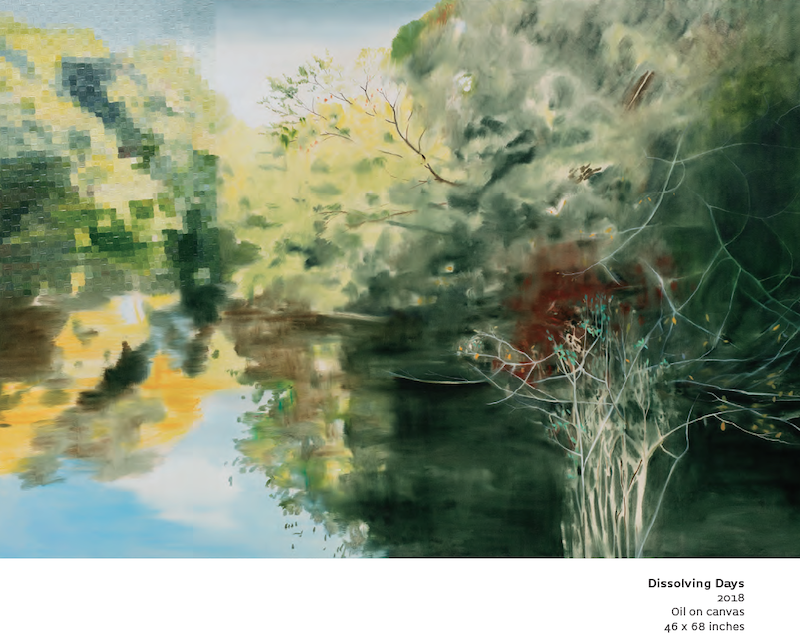
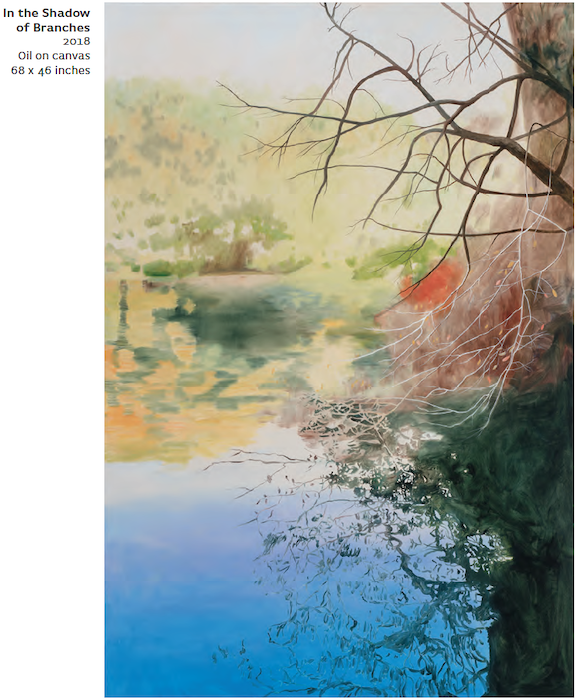
For Eakins, the empiricist of sight, these two worlds remained fairly distinct. For Preston, who relishes the paradoxes of perception and our current sense of its contradictions and limits, the relationship of objects and reflections is more ambiguous. Looking at her painting Dissolving Days, trees and vegetation fuse with their reflections, fulfilling one implication of its title. And she makes that happen so seductively, one passage of soft green gliding into another. This title conveys other meanings as well. Preston is painting the way we see in another way: you will surely notice that portions of the picture fragment into small grids, as if pixelated, as if there was an interruption in the picture surface: interrupting—dissolving—its continuity. The phrase “dissolving days” also suggests the evaporation of time, a sense of peace as we experience it when we cease worrying about appointments and schedules and concentrate on what is right before our eyes. In her other paintings of 2018, the atmosphere of time suspended is equally evident.
 This overarching sense of quiet is accompanied by a complexity of vision, as Preston’s rendering of the space of water in these paintings reveals. Whether it be in the subtly shifting tones of blue or the way reflection borders on these areas of water, the structural shifts are multiple in such richly realized paintings as November Garden. There is an additional complexity in many other paintings, like An Hour into Spring, In the Shadow of Branches and The Tenderness of Leaves, that is so gracefully employed that most viewers may simply see it as integral to the overall effect of the pictures—which it ultimately is. Preston foregrounds the branches of trees in a prominent way. They enter the pictures from both left and right, fragments of trees we won’t see in full. We are lured into focusing on the beauty of the small details in nature. It is the introduction of these characteristics in a painting—the slender branch and the delicate leaf—that keeps our eye shifting from close to far. These paintings (and their titles) coax us into paying attention—not only to the paintings, which richly reward such scrutiny, but also to the details of the world at large. Take note of how your eye is drawn first to the pattern of leaves and branches before it travels further into any of these images. Then register how the pixelated portion of a picture sets up a contrast with a smoothly rendered section. It’s a display of point and counterpoint, expertly balanced.
This overarching sense of quiet is accompanied by a complexity of vision, as Preston’s rendering of the space of water in these paintings reveals. Whether it be in the subtly shifting tones of blue or the way reflection borders on these areas of water, the structural shifts are multiple in such richly realized paintings as November Garden. There is an additional complexity in many other paintings, like An Hour into Spring, In the Shadow of Branches and The Tenderness of Leaves, that is so gracefully employed that most viewers may simply see it as integral to the overall effect of the pictures—which it ultimately is. Preston foregrounds the branches of trees in a prominent way. They enter the pictures from both left and right, fragments of trees we won’t see in full. We are lured into focusing on the beauty of the small details in nature. It is the introduction of these characteristics in a painting—the slender branch and the delicate leaf—that keeps our eye shifting from close to far. These paintings (and their titles) coax us into paying attention—not only to the paintings, which richly reward such scrutiny, but also to the details of the world at large. Take note of how your eye is drawn first to the pattern of leaves and branches before it travels further into any of these images. Then register how the pixelated portion of a picture sets up a contrast with a smoothly rendered section. It’s a display of point and counterpoint, expertly balanced.
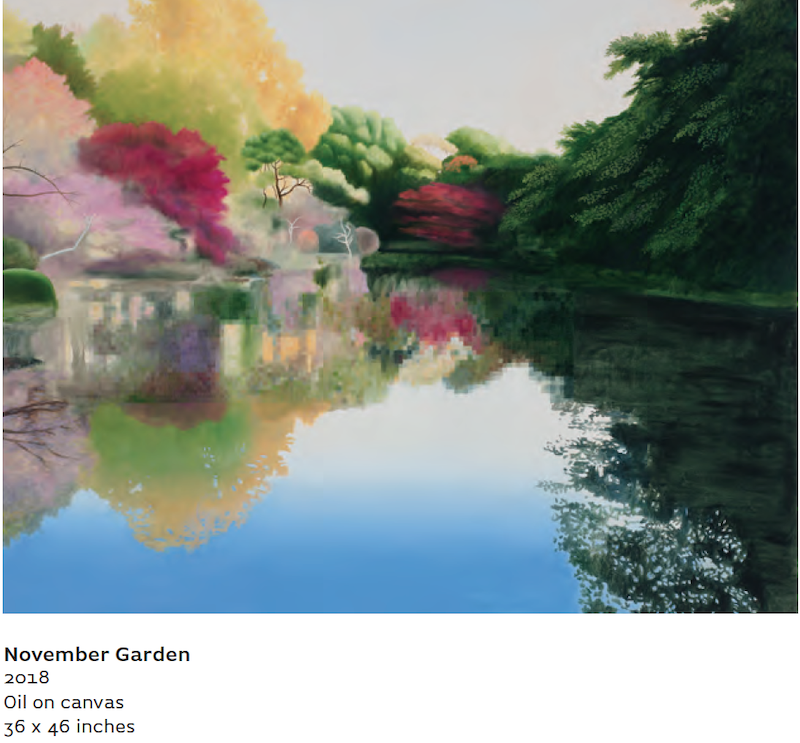 It’s also worth remembering that a painting whose source is a garden is art about art, since with gardens we shape nature to represent a version of beauty. Given that a constant of Preston’s paintings has been pictorial structure, as it pertains to landscape, it shouldn’t seem surprising that she has long been interested in the structure of gardens too. Reaching back to the 1990s, she has given us wonderful examples of paintings that interpret gardens, among them Provence Garden (1995) and Yellow Landscape (1999). Such work is fascinated with how we superimpose geometry on nature, through the design of gardens, and how such places offer possibilities for the painter.
It’s also worth remembering that a painting whose source is a garden is art about art, since with gardens we shape nature to represent a version of beauty. Given that a constant of Preston’s paintings has been pictorial structure, as it pertains to landscape, it shouldn’t seem surprising that she has long been interested in the structure of gardens too. Reaching back to the 1990s, she has given us wonderful examples of paintings that interpret gardens, among them Provence Garden (1995) and Yellow Landscape (1999). Such work is fascinated with how we superimpose geometry on nature, through the design of gardens, and how such places offer possibilities for the painter.
 Seeing as the inspirations for these new paintings are gardens, they also interpret cultivated landscapes, though the sources are not as formal as examples in the European tradition. The given structure of these Japanese gardens is subtler, more natural in appearance. But Preston’s attention to pictorial structure is no less evident in these new works, with their shifts between near views and more distant ones, as well as their transitions from seamless territory to pixelated passages. But as in all her work, structure is only part of the picture. Preston assembles the elements of her paintings into a poetic whole; the image is permeated by a perception of how beauty, physical and perhaps metaphysical, which manifests itself in gardens, assumes an even more inspiring form in these new paintings.
Seeing as the inspirations for these new paintings are gardens, they also interpret cultivated landscapes, though the sources are not as formal as examples in the European tradition. The given structure of these Japanese gardens is subtler, more natural in appearance. But Preston’s attention to pictorial structure is no less evident in these new works, with their shifts between near views and more distant ones, as well as their transitions from seamless territory to pixelated passages. But as in all her work, structure is only part of the picture. Preston assembles the elements of her paintings into a poetic whole; the image is permeated by a perception of how beauty, physical and perhaps metaphysical, which manifests itself in gardens, assumes an even more inspiring form in these new paintings.